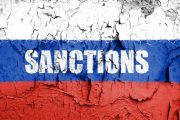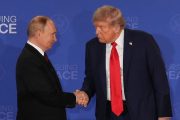On May 3, 2012, Russian Chief of General Staff Nikolai Makarov warned that Russia would deploy its strategic nuclear rockets in Kaliningrad Oblast, potentially to destroy the U.S. antiballistic missile defense system, planned for Europe. Makarov went even further, warning of a possible preemptive nuclear attack. “A decision to use destructive force preemptively will be taken if the situation worsens,” Makarov said.
The planned U.S. missile defense system to protect Europe from a nuclear missile attack has caused much friction between the Russia and United States. Russia considers the antiballistic missile system an encroachment on its traditional “sphere of influence” and a threat to its national security, seeing as it could neutralize Russia’s nuclear deterrence of Europe. In the event of a war, this would give the U.S. and NATO a considerable advantage; the U.S. or NATO would be able to launch a preemptive strike on Russia without having to fear nuclear retaliation. As a result, Russia views the system as an indication the U.S. and NATO intend to go to war with Russia.
The U.S., on the other hand, has repeatedly stated that its intention is not to deter a missile launch from Russia, but from either Iran or North Korea. The U.S. and its NATO partners, including Britain, Poland, and the Czech Republic, are committed to its deployment, while Russia fiercely opposes it. Neither side will budge — that is up until now.
“This is my last election. After my election I have more flexibility,” President Barack Obama privately told Russian President Dmitry Medvedev, at the Nuclear Security Summit, in Seoul, South Korea, on March 26, 2012. Medvedev replied, “I understand you. I transmit this information to Vladimir [Putin], and I stand with you.” Vladimir Putin was not the only person Obama’s “private message” was transmitted to. Unbeknownst to Obama or Medvedev, their conversation was recorded and broadcast live via an open microphone and camera.
“Reset,” New START Treaty, the acceptance of Russian surveillance flights over the U.S., Russian troops training in Colorado, and “flexibility” over missile defense; over the last four years President Obama has gone forward with convergence toward Russia. The U.S. may have stopped fighting the Cold War, but Russia has not.
In February 2012, Vladimir Putin, praised the work of Soviet-era KGB spies for having stolen U.S. nuclear secrets to develop their own bombs. “You know, when the [United] States already had nuclear weapons and the Soviet Union was only building them, ‘we got a significant amount of information through Soviet foreign intelligence channels,’” Putin said, according to Itar-Tass. Putin continued, “They were carrying the information away not on microfilm, but literally in suitcases. Suitcases!”
Today, Russia possesses a total of 12,987 nuclear warheads. This is more than the amount owned by the United States and the rest of the world combined. Despite its nuclear supremacy, Russia has an even far more formidable weapon in its military arsenal.
EMP
Since 1963, the Soviet Union has conducted an array of tests with non-nuclear EMP weapons for potential use against the U.S. in a first strike attack. EMP, or electromagnetic pulse, is a burst of electromagnetic radiation capable of destroying all electrical power, radio waves, and digital signals over a wide area. The burst of electromagnetic radiation moves instantaneously, making ordinary surge protectors useless and would neutralize all electrical equipment, such as computers, laptops, television sets, landline telephones, cellular phones, air conditioners, refrigerators, electric stoves, microwaves, automobiles, airplanes, trains, ATM machines, hospital equipment, computer-run waterways and sewage systems.
Although all nuclear weapons can also be EMP weapons, not all EMP weapons are nuclear weapons. A nuclear bomb detonated at a high enough altitude has the same capability as an EMP of destroying all electrical power, radio waves, and digital signals over a wide area. A non-nuclear EMP weapon does not produce the destructive blast of a nuclear weapon; rather it only emits the burst of electromagnetic radiation, which is relatively harmless to the human body especially from the intended altitude of detonation. The radiation does not result in any damage to man-made or natural structures.
Nevertheless, an EMP attack could shut down the entire U.S. power grid, Wall Street, the banking system, airports, and hospitals. People living on pacemakers and other hospital equipment would die. The lack of refrigeration and running trucks would spoil U.S. food reserves and supermarket goods, resulting in mass starvation. According to Dr. Lowell Wood, Ph.D., an astrophysicist at the Lawrence Livermore National Laboratory and who worked on the Strategic Defense Imitative (SDI) in the Reagan administration, an EMP attack could “literally destroy the American nation and might cause the deaths of 90% of its people and set us back a century or more in time as far as our ability to function as a nation.”
In 2001, Congress established the Commission to Assess the Threat to the United States from Electromagnetic Pulse (EMP) Attack. In its first report, released in 2004, the EMP Commission reported that “China and Russia have considered limited nuclear attack options that, unlike their Cold War plans, employ EMP as the primary or sole means of attack.”
Although the number of Russian nuclear weapons has been greatly reduced since the fall of the USSR, Russia’s EMP arsenal is believed to be “at its maximum Cold War strength,” according to retired U.S. Army Colonel Dan Dickerson, who has served as an advisor to the UN, NATO, and Interpol on terrorism and intelligence planning.
In a May 2012 article in The Journal of Counter Terrorism & Homeland Security International, Col. Dickerson wrote, “Russia and China have conducted extensive research into their [EMP] development and possible deployment against the U.S.” In May 1999, Congressman Roscoe G. Barlett (R-Md.) relayed the following:
We met with three of our Russian counterparts on the Duma International Affairs Committee, including its chairman, Vladimir Lukin, and senior Communist Party member Aleksandr Shabonov. The Russians chastised the United States for military aggression in the Balkans and warned Russia was not helpless to oppose Operation Allied Force. Lukin said, “If we really wanted to hurt you with no fear of retaliation, we would launch an SLBM [submarine launched ballistic missile] and detonate a single nuclear warhead at high altitude over the United States and shut down your power grid and communications for six months or so.” Shabonov added, “And if one weapon wouldn’t do it, we have some spares.”
Similar threats has been reiterated by the Russian military. In 2004, Russian Major General Vladimir Belous wrote:
Space-based and ground facilities of the information-reconnaissance system, without which the missile defense system will prove to be “blind,” are especially vulnerable in this sense. During a crisis situation period, “space” mines can be inserted into space. They are dispersed in orbit around enemy objects and, detonating on command from Earth, disable them at the necessary moment. The ‘blinding’ of enemy territory by disabling his electronic power network also is possible. American specialists determined that in case a large nuclear charge were detonated at an altitude of hundreds of kilometers above the geographic center of the United States, the state of Nebraska, a powerful electromagnetic pulse will disable electronic power system on the territory of the entire country for a certain time.
While the threat of a Russian-launched EMP attack against the United States is real, Russia might very well launch one by way of one of its proxies, or surrogate states.
Satellite States
Dr. Peter Vincent Fry, a former CIA nuclear weapons analyst and staff director of the EMP Commission, stated in 2004 that a group of Russian nuclear scientists had informed him that they had already handed the technology for a “super-EMP” to Iran and North Korea and that Russian scientists have assisted the North Koreans in developing their own EMP weapon.
In addition to North Korea, Russian arms have also made their way to Nicaragua, bolstering the regime of communist Sandinista President Daniel Ortega. “The whole Nicaraguan Army and other power agencies use arms and vehicles mostly of the Soviet and Russian production. We do not return to a bare field in Nicaragua, but resume our relations on a very serious basis, both technological and human,” stated former Russian Prime Minister Sergei Stepashin, during a state visit to Nicaragua, in 2007.
In February 2010, Russian Foreign Minister Sergie Lavrov announced that Russia and Nicaragua would be preparing joint military exercises, similar to those conducted between Venezuela and Russia. “We have military and technical cooperation to jointly strengthen the potential of our army and police in fighting against drug trafficking and organized crime,” Ortega said.
Russia also enjoys cozy relations with the Islamic Republic of Iran and the Bolivarian Republic of Venezuela. Venezuela leader Hugo Chavez, a member of the United Socialist Party of Venezuela, has referred to his government as a “Bolivarian revolution.” In his third presidential inauguration speech, in 2007, he said, “Those of you who want to know what type of socialism I have planned for Venezuela should read Marx and Lenin.”
Russia has greatly increased its diplomatic relations and military ties with Chavez’s Venezuela. In 2005, Chavez signed an agreement with the Kremlin, in which Russia agreed to sell over $4.4 billion worth of arms to Venezuela. These arms included “10 Mi-35 combat helicopters, 3 Mi-26 heavy transport helicopters, 40 Mi-17 multi-role helicopters, 100 000 AK-103 rifles, and 24 Su-30MK combat aircraft,” according to Novosti.
In 2008, a fleet of Russian warships sailed to Latin America to conduct joint war games with the Venezuelan Navy. That same year Russia landed two Tu-160 strategic nuclear bombers on a Venezuelan air force base. “I’m going to fly one of those beasts,” Chavez joked. He explained that the two Tu-160s would be conducting maneuvers over Venezuelan and neutral airspace as part of a move towards a “multi-polar world.” Chavez continued, “The Yankee hegemony is finished.”
In 2010, Chavez visited Tehran, where he met with his Iranian counterpart Mahmoud Ahmadinejad. The two leaders pledged to strengthen their strategic relationship and denounced U.S. “imperialism.” Ahmadinejad said, “Iran and Venezuela are united to establish a new world order based on humanity and justice.”
In addition to giving Iran “super-EMP” technology, Russia has cooperated with Iran over military affairs. On November 13, 2011, The Washington Post reported that former Soviet weapons scientist Vyacheslav Danilenko was one of the “foreign experts” who worked on Iran’s nuclear program. The following month, Iran announced that it had shot down and captured a U.S. RQ-170 unmanned aerial vehicle, for which according to the Iranian media, it has already received requests from Russia and China to examine.
Back in June 2011, Iranian Brigadier General Amir-Ali Hajizadeh, the commander of the Islamic Revolutionary Guard Corps’ aerospace unit, admitted to having shown Russia previous U.S. drones it had captured. “Russian experts requested to see these drones and they looked at both the downed drones and the models made by the Revolutionary Guards through reverse engineering,” General Amir-Ali Hajizadeh said.
Unlike Cuba, North Korea, and Venezuela, Iran is not a revolutionary socialist or communist country, but it has been a strategic ally of Russia since the Iranian Revolution of 1979. On February 23, 1981, while delivering the “Report of the Central Committee of the CPSU” to the 26th Congress of the Communist Party of the Soviet Union, Soviet leader Leonid Brezhnev acknowledged the 1979 Iranian Revolution as “essentially an anti-imperialist revolution.” Brezhnev went on to express his support for Iran and declared, “The banner of Islam may lead into struggle for liberation.” In the same speech, Brezhnev declared, “No one should have any doubts, comrades, that the CPSU will consistently continue the policy of promoting cooperation between the USSR and the newly-free counties, and consolidating the alliance of world socialism and the national liberation.”
This Soviet strategy remains true today, despite the alleged demise of the USSR. Rather than looking back at the words of such former Soviet leaders, the media has responded to Russia’s resurgent activities with sporadic headlines that read “New Cold War” or “The Cold War is Back.” This could not be any further from the truth.
“I don’t agree that the Cold War is back. It never ended,” said Andrei Lugovoi, a representative in the Duma, Russian parliament, in 2000. In 2007, Vladimir Putin reiterated the continuation of the Cold War by threatened the West with a “new spiral in the arms race.” In the eyes of Russia, the Cold War never ended; they are still fighting. In 1960, warning about the Soviet menace, Senator Barry Goldwater, in The Conscience of a Conservative, wrote, “Our enemies have understood the nature of the conflict, and we have not. They are determined to win the conflict, and we are not.” Goldwater’s words resonate today as Russia continues to fight the Cold War through the use of EMP weapons and its reliance on satellite states.
Photo: With the hammer and sickle and CCCP emblems of the old Soviet Union visible, Russian howitzers roll down the Red Square during the Victory Day military parade in Moscow. Russia, on May 9, 2011: AP Images





